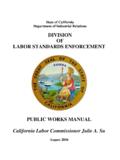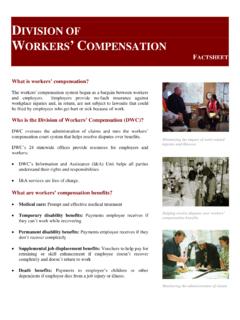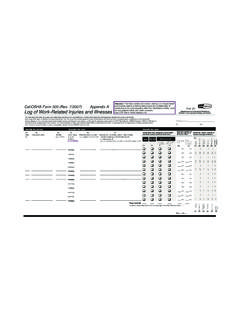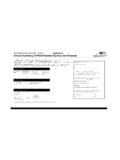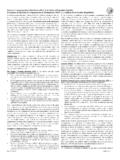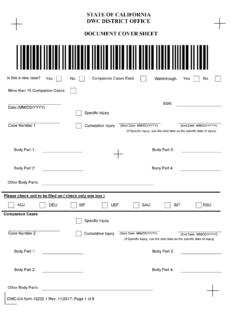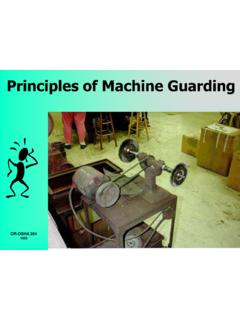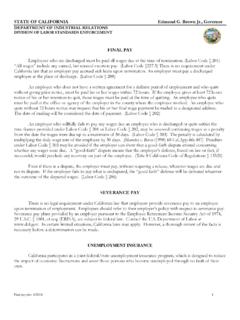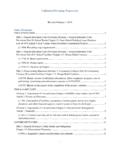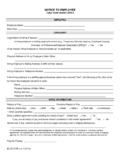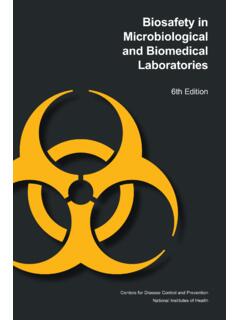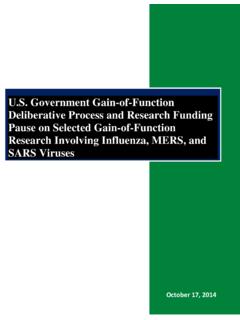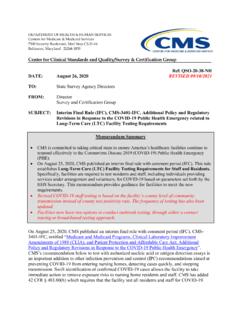Transcription of Aerosol Transmissible Diseases
1 SAFETY & HEALTHFACT SHEET California Department of Industrial RelationsDivision of Occupational Safety & HealthPublications UnitSAFETY & HEALTH | FACT SHEET Aerosol Transmissible Diseases Photo credit: The CDC Aerosol Transmissible Diseases (ATDs), such as tuberculosis and measles, are transmitted by infectious particles or droplets through inhalation or direct contact with mucous membranes in the respiratory tract or eyes. ATDs that spread viathe airborne route are called airborne infectious Diseases (AirID). Certain California employers are required by California Code of Regulations, title 8, section 5199 to reduce theiremployees risk of infection to ATDs. This fact sheet briefly summarizes the requirements. The standard also covers Aerosol Transmissible pathogens laboratory (ATPs-L), which are aerosolized in lab procedures. ATPs-L are pathogens for which BSL-3 precautions are recommended by either the CDC s biosafety in Microbiological and Biomedical Laboratories or the lab s biosafety officer.
2 Pathogens that are novel or listed in Appendix D are also ATPs-L. Examples include Coccidioides immitis and Legionella pneumophila. Laboratory exposures to zoonotic ATDs (those transmitted from animals to humans) are also covered by section 5199, but zoonotic ATD exposures in non-laboratory settings are covered by the ATD-zoonotic standard, section What Employers Are Covered? The standard applies to employers that have employees with occupational exposure, defined as exposure from work activity or working conditions that is reasonably anticipated to create an elevated risk of contracting any disease caused by ATPs or ATPs-L if protective measures are not in place. Some employers must comply with the full standard but others are only required to comply with certain parts, provided they meet specified criteria. Full-standard employers are those that may provide diagnosis, treatment, and other services to AirID patients.
3 Examples include general acute care hospitals, emergency medical services, some correctional facilities, and certain laboratories and medical offices. Subsection (d) requires them to have a written exposure control plan that describes recordkeeping, exposure incident investigation procedures, control measures including airborne infection isolation, and more. Referring employers are those that screen persons for AirID; refer confirmed or suspected AirID cases to another health care provider for treatment; do not provide medical treatment to such cases beyond first aid, screening, and referral; and do not provide transport, housing, or airborne infection isolation to them beyond non-medical transport in the course of referral. Examples are primary care clinics; many skilled nursing facilities; and jails that do not provide ongoing treatment, housing, or other services to AirID cases or suspected cases.
4 Referring employers must comply with subsection (c), including written procedures, training, and medical services. Laboratories where employees perform procedures that may aerosolize ATPs-L must comply with subsection (f), including a written biosafety plan, medical services, and recordkeeping. If laboratory employees have contact with ATD cases, suspected cases, or potentially infected cadavers, the laboratory must also comply with applicable parts of the full standard. Clinical, public health, research, production, and academic laboratories that have contact, as described above, are covered by this standard. The lab biological safety officer must conduct a risk assessment to determine protective measures, which may include BSL-3 precautions. Dental practices and outpatient medical specialtypractices are exempt from this standard only if they meet all the conditions of subsection (a)(2).
5 Screening Procedures Referring employers and outpatient medical specialty practices must screen patients for AirID and ATD, respectively, and refer suspected cases for treatment. Dental practices must screen for ATD and may refer suspected cases. All staff who may have contact with the public must be trained on the screening procedures. Appendix F contains sample screening criteria for non-medical workplaces. Subsection (c)(3)(B) lists the conditions when people must be referred. The employer must prevent disease transmission while the symptomatic patient is present with procedures such as having the patient wear a surgical mask. Employee Involvement and Communication Employers must designate someone to be responsible for implementing their written procedures, exposure control plan, and/or biosafety plan and involve their covered employees in updating it annually.
6 All covered employers except labs without patient contact must communicate with their employees and other employers about the infectious disease status of contacted patients and any unprotected ATD exposure involving their employees or those of the other employers. For example, if paramedics bring a patient to a hospital where staff diagnose the patient with TB, then the hospital must inform the paramedics employer. Both employers must inform their own employees who had significant exposure to the patient and provide timely medical intervention. See details in subsections (c), (d), and (h)(6). Transporting an AirID Case or Suspected Case When transporting an AirID case or suspected case within the facility or in an enclosed vehicle, including helicopters, and the patient is not wearing a surgical mask, employees must wear an N95 or higher level respirator. If the AirID case or suspected case is wearing a surgical mask, then employees need not wear respirators.
7 Additionally, if a respirator may interfere with safe vehicle operation, then it is not required, but the employer must provide other protection, such as barriers, if feasible. Law enforcement or corrections personnel transporting an AirID case or suspected case are not required to wear respirators if their vehicle has a solid partition separating the passenger from the employees, and the employer implements procedures specifying the conditions of operation, tests the airflow, and records the results. See subsection (g)(4)(H) exception 2. Isolation Precautions for ATDs Airborne precautions are used to prevent transmission of AirIDs, such as measles, chickenpox, and TB, which are transmitted by the airborne route. Precautions include wearing an N95 or higher level respirator, gloves, and gown and isolating the patient in a negative pressure airborne infection isolation room or area (AIIR).
8 Droplet precautions are used for pathogens that transmit by close respiratory or mucous membrane contact, like coughing or sneezing. They include wearing a surgical mask, gloves, and gown and housing the patient in a single-patient room. Diseases requiring droplet precautions include seasonal flu, bacterial meningitis, and whooping cough. See Appendix A for the list of Diseases and pathogens requiring each type of precaution. See subsection (e)(1) (A) for further guidance on the precautions. The employer must also use other engineering, work practice, and source controls, as appropriate. High Hazard Procedures High hazard procedures are those that are reasonably likely to generate infectious aerosols, performed on ATD cases, suspected cases, or specimens suspected of containing an ATP-L. Examples are bronchoscopy, intubation, autopsy, manipulation of lab cultures, and aerosolized administration of medications.
9 Employers must determine which procedures performed at their workplace are considered high hazard and list them in their written ATD Exposure Control Plan. High hazard procedures on AirID cases or suspected cases must be conducted in an AIIR or ventilated booth. See below for respiratory protection requirements. When is Respiratory Protection Required? N95 respirators at minimum are required in the situations listed in subsection (g)(4), such as entering a room used for airborne infection isolation; being present during a procedure on an AirID case or suspected case; repairing, replacing, or maintaining air systems or equipment that may contain or generate aerosolized pathogens; and entering an area being decontaminated after an AirID case or suspected case has vacated. Powered air-purifying respirators (PAPR) with HEPA filters are required when employees perform high hazard procedures on AirID cases, suspected cases, or cadavers potentially infected with ATPs.
10 One exception is if the high hazard procedure is performed with the patient in a ventilated enclosure that effectively contains and removes resulting aerosols and the employee never enters. In that case, the employee may wear an N95 respirator. Another exception is that paramedics and other emergency medical personnel in field operations may use a P100, R100, or N100 respirator. Note: Surgical masks are not respirators and do not offer the wearer any protection from ATPs. (left to right) An example of an N95 respirator; an example of a PAPR Medical Services Employers must offer annual TB screenings and recommended vaccinations (see Appendix E for health care workers). After exposure incidents (unprotected exposure to a reportable ATD [RATD] case or suspected case), they must provide employees with timely medical services, in accordance with subsection (h)(6).
